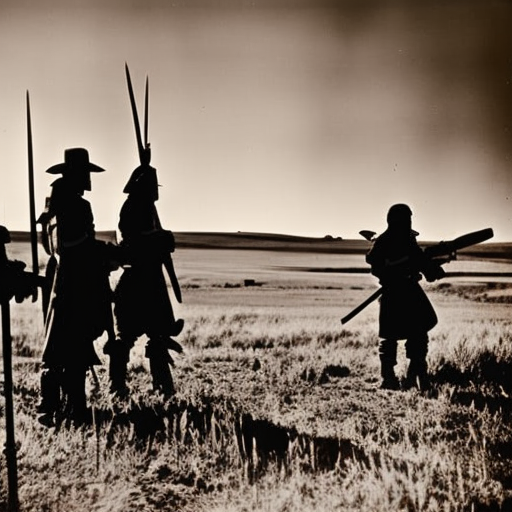Summary:
The Sioux Wars were a series of conflicts between the Sioux Native American tribes and the United States government in the mid to late 19th century. These wars were primarily fought over land and resources in the Great Plains region of the United States. The Sioux tribes, led by leaders such as Sitting Bull and Crazy Horse, fiercely resisted the encroachment of white settlers and the U.S. government’s attempts to control their traditional lands. The wars resulted in significant loss of life and the eventual confinement of the Sioux to reservations.
Background:
The Sioux tribes, including the Lakota, Dakota, and Nakota, had long inhabited the Great Plains region, relying on buffalo hunting for their livelihood. However, as white settlers moved westward in search of gold and land, conflicts over territory and resources became inevitable. The U.S. government sought to acquire Sioux lands through treaties, but these agreements were often disregarded or violated, leading to increased tensions.
The First Sioux War (1854-1856):
The First Sioux War, also known as the Grattan Massacre, was sparked by a dispute between a Sioux chief named Conquering Bear and a U.S. Army officer, Lieutenant John Grattan. The confrontation escalated into violence, resulting in the death of Grattan and his men. In retaliation, the U.S. Army launched a punitive expedition against the Sioux, but the conflict ended inconclusively.
The Dakota War of 1862:
The Dakota War of 1862 was a significant conflict between the Dakota Sioux and the U.S. government in Minnesota. Faced with broken promises and starvation, some Dakota Sioux warriors launched attacks on white settlements. The U.S. Army responded with a campaign to suppress the uprising, resulting in the capture and execution of over 300 Dakota Sioux warriors. The remaining Dakota Sioux were forcibly removed from Minnesota.
The Red Cloud’s War (1866-1868):
Red Cloud’s War was a major conflict between the Sioux tribes and the U.S. government over control of the Bozeman Trail, a key route to the Montana goldfields. Led by Chief Red Cloud, the Sioux warriors launched a series of attacks on U.S. Army forts and supply trains. The U.S. government eventually abandoned the Bozeman Trail and agreed to the Treaty of Fort Laramie, which guaranteed Sioux control over the Powder River country.
The Battle of Little Bighorn (1876):
The Battle of Little Bighorn, also known as Custer’s Last Stand, was a significant event in the Sioux Wars. Led by Sitting Bull and Crazy Horse, a large force of Sioux warriors defeated the U.S. Army’s 7th Cavalry Regiment, led by General George Custer. The battle resulted in the death of Custer and his men, but it also marked a turning point in the conflict. The U.S. government intensified its efforts to subdue the Sioux tribes.
The Wounded Knee Massacre (1890):
The Wounded Knee Massacre was the final major confrontation of the Sioux Wars. It occurred when the U.S. Army attempted to disarm a group of Sioux at Wounded Knee Creek in South Dakota. A scuffle broke out, and the soldiers opened fire, killing around 150 Sioux, including women and children. The massacre effectively ended armed resistance by the Sioux.
Aftermath:
Following the Sioux Wars, the U.S. government imposed further restrictions on the Sioux tribes, confining them to reservations and attempting to assimilate them into mainstream American society. Many Sioux leaders, such as Sitting Bull and Crazy Horse, were killed or captured, and their resistance was effectively crushed. The Sioux Wars left a lasting impact on the Sioux tribes, as they lost their traditional lands and way of life.
In conclusion, the Sioux Wars were a series of conflicts between the Sioux tribes and the U.S. government over land and resources in the Great Plains region. These wars resulted in significant loss of life and the eventual confinement of the Sioux to reservations. The conflicts, including the Dakota War of 1862 and the Battle of Little Bighorn, highlighted the Sioux tribes’ fierce resistance to white encroachment. The Sioux Wars had a lasting impact on the Sioux tribes, as they lost their traditional lands and were forced to adapt to a new way of life on reservations.












